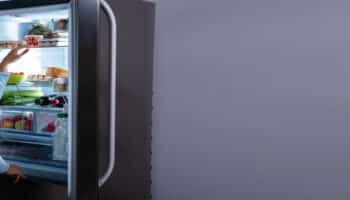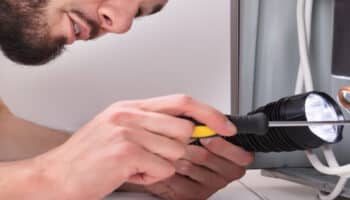Keep finding that your refrigerator is trying to make its own swimming pool?
A refrigerator filling with water is quite a common problem. If that’s what you’re stuck with – you’re not alone.
Water pooling in a refrigerator is often caused due to a blocked drainage pipe. Removing this blockage at the surface or with a wire can help allow the pooled water to flow fully. Alternatively, water in a fridge could be from a leaking water filter or dirty drain pan.
If you want to solve this issue, you’re in the right place.
Below you’ll find all 4 common solutions to fixing a refrigerator that’s filled with water. If you’re ready to get this issue solved, then read on.
#1 Dirty Drain Pan
A dirty drain pan is a very common issue that causes water to collect, back-up and eventually flood around the base of the refrigerator.
The point of a clean drain pan is to collect water from the defrost cycle of your freezer for evaporation. Things like mold, dirt, and even dead bugs can accumulate in it over time. Now water is sharing space with debris. The pan is not meant to be a tray for trash, just water.
As a result of this dirt and other stuff, the pan’s surface area is reduced. This can cause inefficient evaporation of the defrost water.
Basically, the water the pan was designed to handle is overwhelming. This equals poor evaporation.
All thanks to some build-up.
Next thing you know, you have flooding conditions in your kitchen.
Removing the pan and performing a quick inspection will tell you right away if that is your problem. You’ll probably discover it’s full of dirty water and who knows what’s floating in it. The fix could be as simple as a deep cleaning or, if it’s really nasty or corroded, you can purchase a brand new one all together. Consult your owner’s manual for appropriate replacement parts.
#2 Your Defrost Pipe Is Clogged
A very common reason water may be backing up into your refrigerator is that your defrost pipe has become clogged. As with the drain pan, debris, mold, or ice can eventually build up, preventing sufficient draining during your refrigerator’s defrost cycle. When this happens, you may water anywhere from under vegetable bins to on the floor.
You can fix this by getting hot water and flushing the drain line, repeating as necessary until the line is clear. If you’re unable to remove the source of the clog, you may need to replace the drain. Again, consult your owner’s manual for appropriate replacement parts.
Do not be tempted to use boiling water. Although boiler water could be effective, if the clog is unable to be resolved, the boiling water may be trapped and can damage the PVC material of your drain pipe.
Lastly, you may also want to also inspect your defrost timer and heater while doing all this other work. If there is an issue with either one of them, chunks of ice that should have melted and didn’t before going into the drain, may indicate your defroster isn’t working well.
This is usually due to the refrigerator being older and those parts starting to fail. This could lead to more ice getting into the drain and getting stuck on other debris, causing a backlog in the line.
#3 You Have a Broken Water Line
If you have a refrigerator that has a water/ice dispenser, you may have a cracked line or hole you’re dealing with. Hey, sometimes things just break and have to be replaced with new parts. There’s nothing you can really do to anticipate that. But that doesn’t mean you have to replace the refrigerator itself.
The easy fix here is to just replace the affected part of the dispenser. If it’s a more difficult job than you can handle, or the part is not one easy to find, you may want to consult a repair technician to order the part and do the job for you.
Not the most enjoyable option. But then again, things aren’t always in your control.
#4 Your Water Filter Is Leaking
Have you recently replaced your water filter and now are discovering water flooding the inside of your refrigerator? Well, your problem is your water filter is probably not seated right.
This can be frustrating because sometimes you don’t notice water building up for days. Then one day, you notice water pooling on the floor around the front of your refrigerator. But it’s not the drain and not the drain pan. And you can’t even find where the water is coming from.
Nothing makes sense.

Now if your water filter is mounted on the overhead of the refrigerator (usually in a corner somewhere), you’ll see water on the top shelf or running down the inside. It’s easy to figure out what’s happening in this case and won’t leave you pulling your hair out.
But if you have a refrigerator with a center drawer, the water filter might be installed in the middle right above it in the main box.
As you can see in the picture, this appears to be a very efficient design. Easy to get to. Twist and pull. No problem.
But where the filter locks in place, it is not visible to investigate, so there’s no way to see if it is seated correctly or if there is a leak or not. You’ll hear the swish of running water and figure everything is good to go.
What happens is, if the filter isn’t seated right or has a bad seal, water will leak from the back of the fridge and down into the middle drawer. Which you might think would hold the water like a bucket.
However, in the drawer, there are air vents in the rear. So, the water then passes through them and collects underneath the drawer.
After days of water silently collecting underneath the drawer, you start to see the water leaking onto the floor.
At least you’ve identified where the leak is coming from. Next is the fun part.
You have to remove the filter to stop the leak and then remove the insert from the middle drawer. And what you’ll usually find is a whole lot of standing water. Water, which has no drain in this area, must be soaked-up by hand with towels to get it out.
This is far from fun.
But the fix is easy. Look at the filter seal and check for damage. Then identify if the filter is the same as the current brand of the refrigerator. If it’s not, you probably need to go get a new filter whose brand name is the same as the refrigerator.
Often times, even though a company may say their brand’s filter can be used on other brands, sometimes not so much. So, if you have a Samsung refrigerator, you will want to get a Samsung filter.
If you want to get any replacement part – or see how much one would cost – click to enter your model number in the search bar below. Our partners at AppliancePartsPros stock almost every part with free guides on how to install them.

Conclusion
Plumbing issues can be a pain in the butt and the wallet. It’s easy to forget that this doesn’t just apply to washing machines, dishwashers, or other plumbing. And of course, no one wants to deal with those kinds of issues, especially with the appliance relied on to keep the perishables nice and cold.
Yet, it’s not always the end of the world. With a little investigation and troubleshooting, what looks like could be a major issue might be a simple fix.







